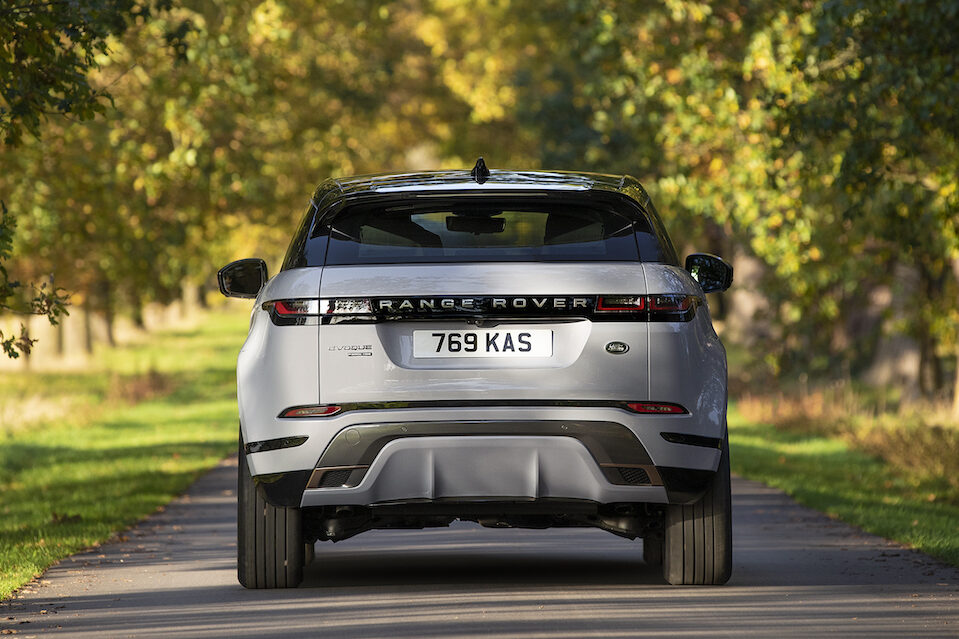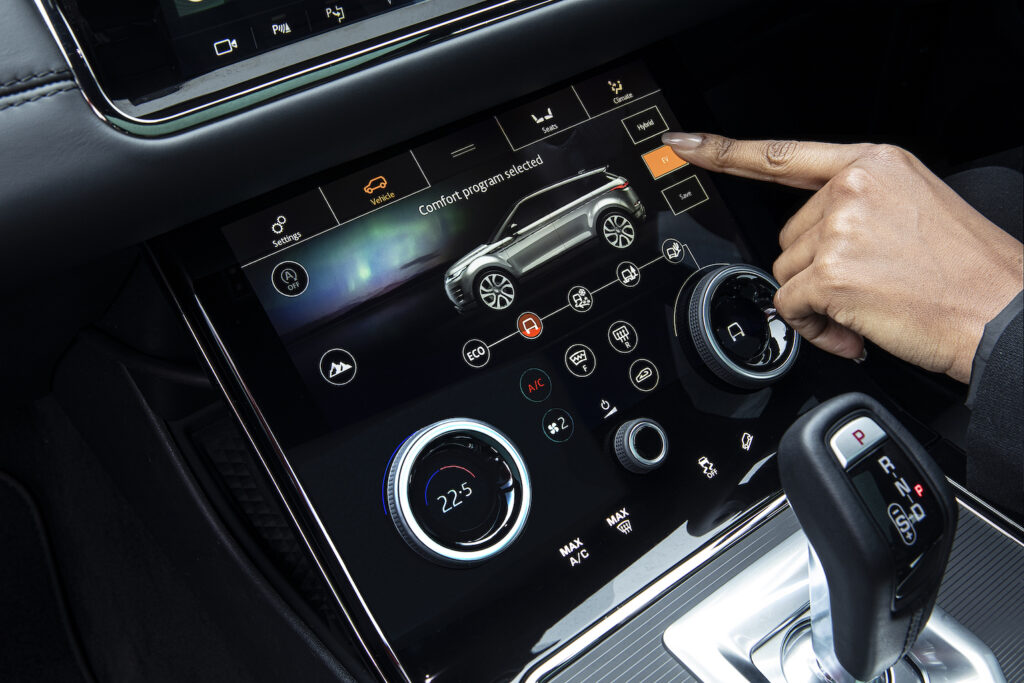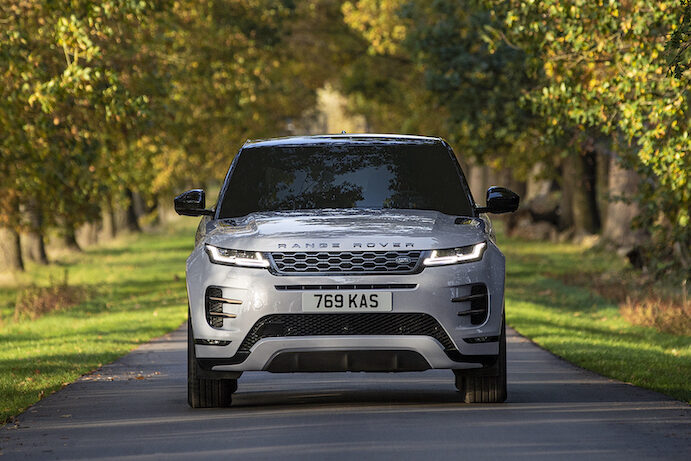The Range Rover Evoque needs little introduction. The ever-popular Defender may be the model that Land Rover is best known for, but the reality is that it’s been the Evoque that has been the bread and butter of the model line-up. With 800,000 sales globally since 2011, it’s the Evoque that has kept the lights on and the bills paid. It’s no exaggeration to say that without it, Land Rover simply wouldn’t be where it is today.
And now, for the first time with this latest generation model, we finally have a plug-in hybrid version of the Evoque, this P300e to join the existing mild hybrid models.
Range Rover Evoque PHEV – Design

As you might expect, not much has changed on the outside with the plug-in hybrid version of the Range Rover Evoque. That’s just as well too as we’ve always been fans of the Evoque’s design – the only giveaway is the second charging flap on the nearside rear wing with the petrol filler on the offside rear wing.
It’s slightly unusual to have the charging flap at the back of a plug-in hybrid as it’s not a terribly convenient location. The result will probably mean that owners have to reverse up to a charging point, rather than the usual parking nose on.
Range Rover Evoque PHEV -Power and range

The Range Rover Evoque P300e is powered by a 1.5-litre, turbo-petrol engine along with a 15kW battery located under the rear seats. Together they produce the equivalent of 309bhp going to all four wheels through a eight-speed automatic gearbox. It’s enough to get the Evoque from 0 to 60mph in 6.1 seconds and onto a 132mph top speed with an all-electric range of up to 34 miles.
Officially, the Evoque P300e will manage 141mpg average fuel economy, although as ever with plug-in hybrids that’s to be taken with a large pinch of salt – especially so if you start to take advantage of that available performance.
Slightly unusually for a plug-in hybrid though is that the Evoque can be charged via a three-pin domestic socket, a Type 2 cable or via a rapid charger. We’re not aware of many plug-in hybrids that even have a socket for a rapid charger, let alone of course have the capacity to take a high level charge in the first place. And we’re not sure how many electric car driving friends you’d win either if you took up a rapid charge place at a busy charging point.
At a rapid charging point, Land Rover quotes a recharge time of 0 to 80 per cent of 30 minutes at 32kW, while on a domestic plug socket, a full recharge takes six hours and 42 minutes. Longer than most plug-in hybrids perhaps, but fine for overnight.
Range Rover Evoque PHEV -On the road

It comes as little surprise when there’s the equivalent of 309bhp under your right foot, that the Evoque P300e feels distinctly sprightly on the road. The throttle pedal feels sensitive and quick to react when you’re on the road and certainly more lively than what you might be expecting. There’s a definite sporting feel, if not exactly sporty.
Part of that of course will be that, while the batteries add weight, the engine itself, a three-cylinder 1.5-litre turbo-petrol, is a not-inconsiderable 37kg lighter than the four-cylinder version of the same engine found elsewhere in the Evoque range. And that’s combined with the eight speed automatic which is another 5kg lighter than the nine-speed auto used elsewhere.
The Evoque plug-in hybrid has three driving modes to choose from – Hybrid, EV and Save – the last of which retains any charge in the battery for later use. The full EV mode will only switch off the engine when there is enough charge in the battery.
The Range Rover Evoque P300e’s ride quality is exceptional despite the HSE model we drove running on 20in alloy wheels, while there’s little road or wind noise either. There’s no question that the overall refinement is exceptional and head and shoulders above the original, first-generation Evoque.
Downsides? There’s no way of adapting the level of brake energy regeneration which is disappointing. It’s noticeable when you lift off the throttle pedal but for us we’d like the regeneration to be stronger.
Range Rover Evoque PHEV -Interior

Again, there’s no doubt that this second-generation Evoque has taken a step forward in terms of quality and materials. There’s plenty of soft-touch plastics and we love the grey velour and fabric seats.
The touchscreen and infotainment system is good, but it could do with being in a portrait format rather than the current landscape. We’re also not fans of the heater controls being on the lower screen down by the gear selector which means you have to take your eyes off the road even for basic things such as changing the cabin temperature.
The eco data menu is helpful though as it can show how turning off items such as the air conditioning, front or rear heated windscreens, heated steering wheel or heated seats will improve your economy and by how much.
In terms of space, the P300e remains the same as the rest of the Evoque range. Head and legroom in the rear seats for adults is reasonable rather than good while boot space creditably remains the same at 472 litres with the rear seats up and 1156 litres with them folded down.
Range Rover Evoque PHEV -Summary
We’re big fans of the Range Rover Evoque and the availability of a plug-in hybrid version only expands that appeal still further. Even better, with great credit to Land Rover’s engineers, is that the car’s practicality hasn’t been compromised to any great extent either. Realistically, the rapid charging capability is unlikely to be used on a regular basis by many owners, but it’s an added bonus.

Fact box
Model: Range Rover Evoque P300e Plug-In Hybrid
Price: from £43,850
Power: Petrol – 1.5-litre turbo; Battery – 15kWh
Electric range: 34 miles
Average fuel consumption: 141mpg
CO2 emissions: 44g/km
Rating: 9/10

